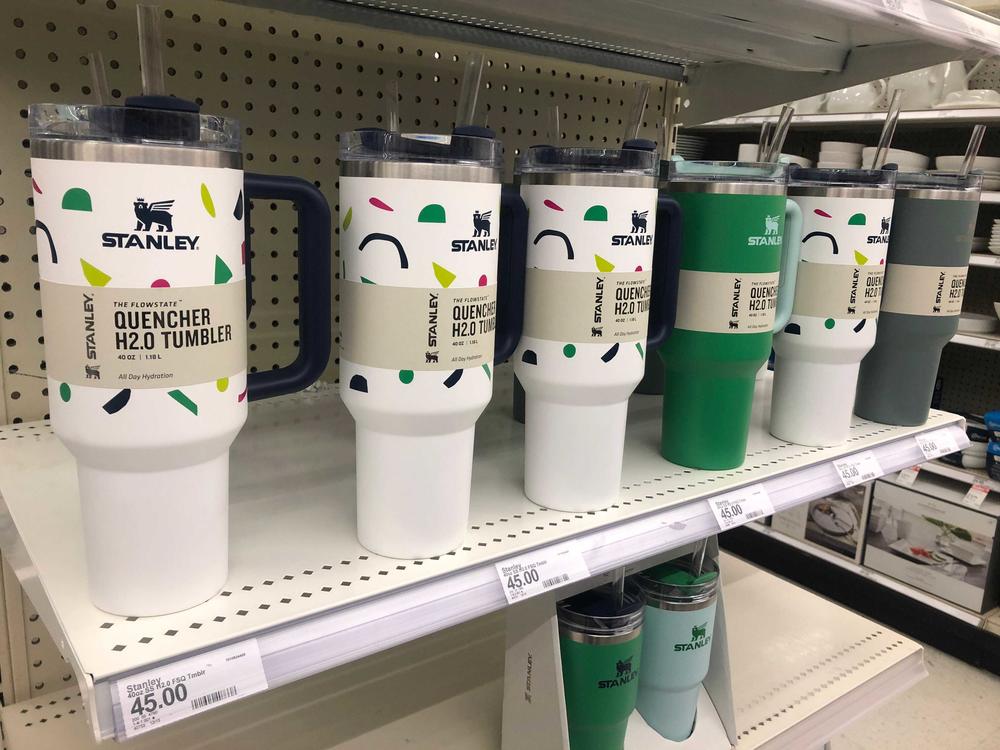@vincentmarcus Camped out at Target for the new viral pink Starbucks Stanley cup thing for my kiddo. Ridiculous? Yes. Fun? Also yes…😜#StanleyCup ♬ original sound - VincentMarcus
Section Branding
Header Content
Overnight lines and mayhem in stores. It's not a new iPhone — it's a Stanley tumbler
Primary Content
It seems that every so often, a different water bottle has its turn at being the cup everyone has to have. There was Nalgene, CamelBak, then S'well and, in the past few years, Hydro Flask — indicating the growing desire over the years for reusable bottles that are nonplastic.
Now, it's the Stanley cup's turn (not to be confused with the trophy awarded each year to whichever team wins the NHL championship). The brand's "Quencher" model in particular has had a resurgence among women and a younger clientele.
The fever was on display last week when people camped outside overnight at Target stores just to get their hands on a limited-edition "Stanley + Starbucks" collaboration. One man went so far as to jump the counter to steal a box of the pink glossy cups. And late last year, the limited-edition pink and cherry red tumblers caused mayhem at Target.
Ordinarily, the company's popular Quencher model costs an average of $45, but resellers already are taking advantage of the hype by posting the limited-edition ones on sites like eBay for hundreds of dollars. Even the hashtag #stanleybrand has 65.3 million views on TikTok, while #stanleytumbler alone has 1 billion views.
So what's the craze behind these seemingly ordinary bottles?
The status symbol that hydrates
The Stanley brand boasts about the superior quality of its popular tumblers, which are double-wall stainless steel and able to keep liquids hot or cold for extended periods of time. The bottle is heavy — Quenchers can carry as much as 64 ounces of liquid — but it has the size to keep a person fully hydrated and also still be able to fit in a car's cup holder due to the tumbler's tapered bottom.
As a testament to its durability, last November a woman's car endured a fire and amazingly one of the few things that could be salvaged was her Stanley water bottle, which still contained ice afterward.
"I couldn't think of a better example of our product's quality," said Terence Reilly, president of Stanley 1913, in a video posted in response to the fire. The Stanley 1913 company offered to replace her vehicle as a result.
Aside from its durability, there is also a lot of emphasis on the enjoyment of drinking through various color options, one of the Quencher's big selling points. The tumbler comes in all variety of colors — from "tigerlily" and "rose quartz" to "charcoal" and "balsam glow."
According to Cassandra Gagnon, an interior strategist at WGSN, a consumer-trend forecasting company, Stanley also offers accessibility in its designs as well — whether it be via the ergonomic handle or its straw.
The Stanley Quencher tumbler is seen "not just like a water bottle," she says, "but a lifestyle and a wellness and a health item as well."
Even though its price tag might be high for some, "it's not a huge price point for a status symbol," says Gagnon, or for a collectible.
A fluid history
After the company's founding in 1913 by inventor William Stanley Jr., the niche that the brand originally found was primarily among men and those who frequented the outdoors. The company's classic thermos was used by pilots in World War II.
But in recent years, through affiliate marketing partnerships with influencers and blogs such as The Buy Guide, and by featuring new colors, Stanley was able to reach new target audiences — initially mostly working mothers — via its Quencher model.
In an interview with Retail Dive, The Buy Guide co-founder Ashlee LeSueur said, "Any brand on the planet that isn't marketing to the 25-to-50-year-old woman is really missing the mark."
Once the brand was able to reach Generation Z, its popularity hit a new level. "And those are also obviously statistically the generations and gender that are online and posting on TikTok and Instagram the most," says Gagnon.
The brand has been able to capitalize on its viral success. According to data reviewed by CNBC, Stanley's annual sales are projected to have surpassed a whopping $750 million in 2023.
But while we might see more chaos around the release of new Stanley Quencher colors, the long-term outlook for the company remains to be seen.
According to Ellyn Briggs, a brands analyst at Morning Consult, a risk comes with Stanley's marketing being so closely attached to TikTok, given the push by some lawmakers to ban the app. "If you live by TikTok, you can die by TikTok as well," she says.
Briggs said it might be wise for the company to create other touch points with consumers. Because, she says, "if TikTok goes away, the question is, does this culture [and] this world that they built there go away as well?"
Copyright 2024 NPR. To see more, visit https://www.npr.org.

